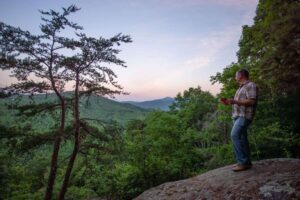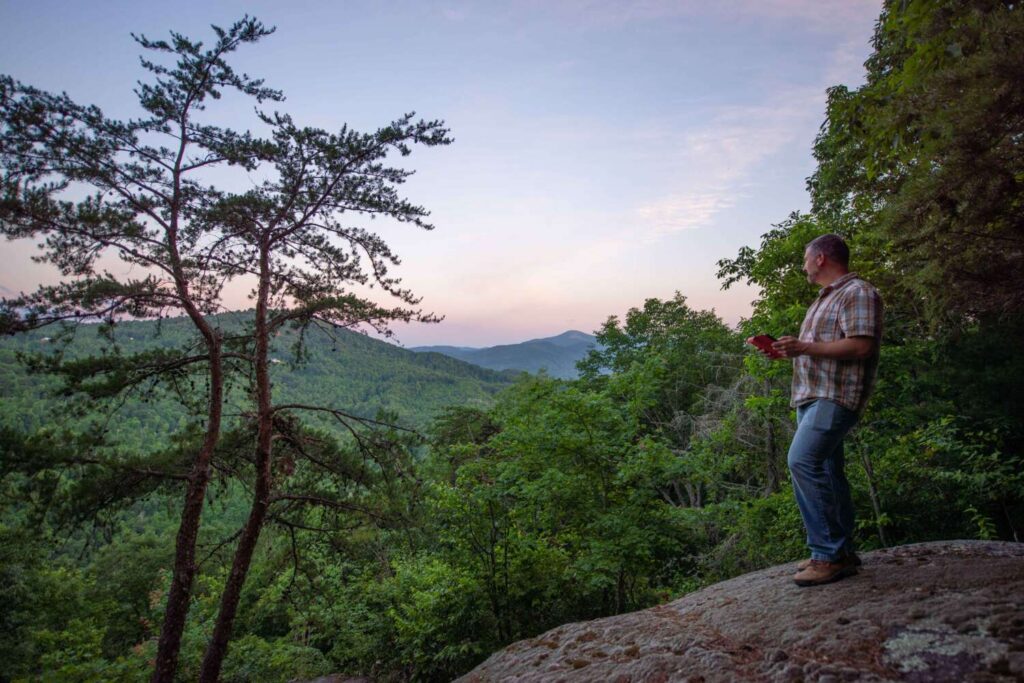Long a popular destination for people looking to reconnect with nature, the Western North Carolina region is attracting increasing numbers of hopeful landowners seeking an escape from crowded cities and a safe haven from climate change.
By teaming up with Green Built Alliance members, prospective landowners will gain a better understanding of the opportunities and constraints of a specific property, inform their decision making, and enter ownership with executable plans to realize their dreams while mitigating risks and avoiding costly mistakes.
Many local buyers prioritize ecological design, sustainability, conservation, and privacy while balancing the need to build a home or family legacy property in the mountains. It often takes a group of professionals including land brokers, land planners, architects, permaculture consultants, foresters, and land trusts to develop a clear and implementable plan for long-term land stewardship.

Finding the property
The land broker is an experienced local land expert and is generally the person that buyers contact first.
The acquisition process starts with a needs analysis that allows the broker to aid them in identifying properties best suited for their goals.
When a potential property is found, land brokers will act as advisors and project managers who assemble highly experienced teams for detailed due-diligence investigation, site planning, design, and education to advise the buyer on how to best accomplish their goals.
This initial work gets further refined in the more detailed master planning after the property is purchased.
Planning the site
Property analysis and conceptual site design is frequently led by land planning and landscape architecture firms.
These firms offer specialized site visits and analysis to develop plans for the client that minimize disturbances to the land, conform with governmental and private restrictions, and consider factors such as roads, building sites, trails, and conservation-easement planning. These services are key to successful due diligence and help all parties understand land-use ordinances, property features and challenges, environmental concerns, stormwater and erosion risks, and stream and wetland delineations.
Land planners also offer other services like soil analysis or natural resource inventories, which are essential in understanding the conservation potential of a property as well as educating all parties involved about sensitive areas and unique habitats.
Collectively, this information is compiled into an overall master plan that becomes the road map for the new landowner.
“It’s so important for a landowner to fully understand any limitations before they make the investment,” said David Tuch, owner and landscape architect at Equinox. “We always recommend first exploring the basics such as access into the property, potential building locations and the identification of any obstacles. Then we can focus on developing a plan for the property from permaculture design to creating a resilient homestead or any other goal our client envisions.”
Considering conservation
Land trusts help us protect the land and water. The land being placed in a conservation easement must have some public benefit and must be accepted by the land trust, but the easement does not always require public access. Normally the conservation efforts will be focused on protecting important plant and wildlife habitat, water quality, forest stewardship and preservation, and/or scenic enjoyment.
In most cases, the buyers of these large family legacy properties are willing to donate an easement to protect these resources in perpetuity for federal tax benefits. While it’s common for these donations to be made years after the landowner buys the property, it’s important to understand up front if the property has the potential to qualify for this use.
There are several local nonprofit land trusts, including Conserving Carolina and Southern Appalachian Highlands Conservancy.
Leveraging the land
Many buyers enjoy working with permaculture consultants in the due-diligence process.
Permaculture-design and landscape-design services help clients understand how to best use areas of the property for their food-production, pollinator-support, and livestock goals. This applies to properties with woodlands, open farmland and meadows, or a mix of features.
Prospective landowners enjoy property walks that enable them to visualize more of what is possible on their land and educate them on how they can apply ecological principles to realize their sustainability and agricultural goals. Other planning can include detailed garden design and plant lists to help them implement self-sufficient and sustainable systems that align with their needs and desires.
“Through the permaculture and sustainability lens, buyers get a clear direction on how to apply ecological principles to realize their sustainability and agricultural goals,” said Laura Ruby, owner and landscape designer at YummyYards. “We listen to the client and the land to best align desires with possibilities. Education also plays a large role in this process, empowering the buyer to more deeply connect with the land.”
Preserving the forest
In our region, many large properties will also have forest land as a substantial component, so it is important to have a consulting forester involved in due diligence.
These professionals help new owners understand and develop new forest-management plans, enroll in state tax programs, and create long-term strategies to improve the health and growth of forests and wildlife habitat on their property. They’re also a key player in evaluating properties for non-native invasive species and helping buyers understand the cost and time necessary to control these so the native species can thrive.
Their analysis, planning, and recommendations also inform the site design, natural resource inventory, and conservation suitability analysis, while educating owners on how to best care for their forests.
“Most forest owners want to be good stewards of their land. We help woodland owners meet their goals by informing their decision making, facilitating forest improvement work, and saving — as well as potentially earning — them money from sustainable and even ecologically beneficial forestry,” said Andy Tait, an North Carolina Registered Forester and forestry director at the professional forestry nonprofit EcoForesters. “We can assess forests to identify forest health issues that threaten forests’ futures and could be costly to mitigate. We also look for opportunities to enhance all forest benefits: recreation, aesthetics, wildlife habitat, biodiversity, water quality, carbon sequestration, and timber. Finally, we implement this work to restore forests.”
Designing the home
Finally, since the ultimate goal for many of these buyers is to create living spaces where they can feel close to and enjoy nature, residences, guest homes, and support buildings are usually part of the plan.
Architects work with the team as part of the initial design and the more detailed master planning processes. They can collaborate on building locations, buildability of a homesite, and shape the features that connect people with the land around them while offering opportunities to showcase nature through the homes they design.
“We love to get involved early in a project so we can help read the land from a construction and end-use perspective,” said Duncan McPherson, principal architect at Samsel Architects. “We can help determine ways for the buildings to work with the land, so they feel like they belong there and reflect the natural character of a place.”
The process of identifying, evaluating, acquiring, and then developing a property with green, sustainable, and conservation goals can be long and complex.
But by working with members of Green Built Alliance throughout the land-acquisition process, buyers can be confident that they have a team of experienced professionals behind them who also value conserving natural resources and the desire for us to all be good stewards of the land.
Pat Snyder is the managing broker of National Land Realty’s Western North Carolina office, a retired military officer, and a Rotarian. National Land Realty supports buyers and sellers across the country with large land tracts (10+ acres) for homestead, conservation, investment, recreation, agricultural, family estate, and residential uses. Connect with Pat at nationalland.com.
You can also view this article as it was originally published on page 44 of the 2021-22 edition of the directory.


